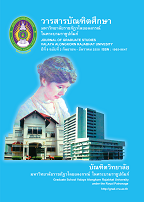การพัฒนาหลักสูตรฝึกอบรมการนวดไทย ภาคตะวันออกของวิทยาลัยชุมชนสระแก้ว THE DEVELOPMENT OF TRAINING COURSES ON EASTERN THAI MASSAGE OF SAKAEO COMMUNITY COLLEGE
Main Article Content
Abstract
บทคัดย่อ
การวิจัยนี้ มีวัตถุประสงค์ 1) เพื่อศึกษาภูมิปัญญาท้องถิ่นการนวดไทย ภาคตะวันออก 2) เพื่อพัฒนาหลักสูตรฝึกอบรม การนวดไทยภาคตะวันออก ของวิทยาลัยชุมชนสระแก้ว 3) เพื่อติดตามผลการฝึกอบรมการนวดไทย ภาคตะวันออก ของวิทยาลัยชุมชนสระแก้ว ตามขั้นตอนการวิจัยและพัฒนา (Research and Development) มีขั้นตอนการดำเนินการ 3 ระยะคือ ระยะที่ 1 การศึกษาภูมิปัญญาท้องถิ่นการนวดไทย ภาคตะวันออก กลุ่มตัวอย่างได้แก่ หมอนวดที่มีอายุ 70 ปีขึ้นไป จำนวน 7 คน ระยะที่ 2 การพัฒนาหลักสูตรการนวดไทย ภาคตะวันออก กลุ่มตัวอย่างได้แก่นักศึกษาแพทย์ แผนไทย จำนวน 20 คน 3) การติดตามผลการฝึกอบรมหลักสูตรการนวดไทย ภาคตะวันออก กลุ่มตัวอย่างได้แก่ประชาชนผู้สนใจหลักสูตรการนวดไทย ภาคตะวันออก จำนวน 20 คนเครื่องมือที่ใช้ในการเก็บรวบรวมข้อมูลการวิจัยในระยะที่ 1 คือ แบบสัมภาษณ์ภูมิปัญญาท้องถิ่นการนวดไทย ภาคตะวันออก ระยะที่ 2 คือหลักสูตรฝึกอบรมการนวดไทยภาคตะวันออก และแบบสอบถามความพึงพอใจของผู้เรียนที่มีต่อหลักสูตรฝึกอบรมการนวดไทย ภาคตะวันออก ระยะที่ 3 คือแบบติดตามผลการฝึกอบรมหลักสูตรการนวดไทย ภาคตะวันออก การวิเคราะห์ข้อมูลทำโดยการแจกแจงความถี่ คำนวณค่าร้อยละ ค่าเฉลี่ย ( ) ส่วนเบี่ยงเบนมาตรฐาน (S.D.) และค่าที (t-test)
ผลการวิจัยพบว่า
1. ภูมิปัญญานวดไทยภาคตะวันออกส่วนใหญ่ เรียนนวดจากบรรพบุรุษ และมีเอกลักษณ์ในการนวดที่แตกต่างกัน สามารถนำเทคนิคการนวดของแต่ละคนมาวิเคราะห์เป็นองค์ความรู้ใหม่นำไปพัฒนาหลักสูตรการนวดไทยภาคตะวันออกได้
2. การพัฒนาหลักสูตรฝึกอบรมการนวดไทยภาคตะวันออก
2.1 ประสิทธิภาพของหลักสูตรฝึกอบรมการนวดไทย ภาคตะวันออก วิทยาลัยชุมชนสระแก้ว ที่พัฒนาขึ้นมีค่าเท่ากับ 80.93/82.33 ซึ่งเป็นไปตามเกณฑ์ที่กำหนดไว้คือ 80/80 ถือว่า มีประสิทธิภาพ
2.2. คะแนนฝึกอบรมของผู้เรียนหลังจากฝึกอบรมด้วยหลักสูตรการนวดไทย ภาคตะวันออก วิทยาลัยชุมชนสระแก้ว สูงกว่าก่อนฝึกอบรมอย่างมีนัยสำคัญทางสถิติที่ระดับ 0.05
2.3. ผู้เรียนมีความพึงพอใจต่อหลักสูตรการนวดไทย ภาคตะวันออก วิทยาลัยชุมชนสระแก้ว อยู่ในระดับมากที่สุด
3. ผู้เรียนที่เป็นกลุ่มประชาชนผู้สนใจหลังใช้หลักสูตรการฝึกอบรมหลักสูตร การนวดไทย ภาคตะวันออก มีอาชีพเสริมเป็นหมอนวด ร้อยละ 85
ABSTRACT
The purpose of the research were: 1) to study the local wisdom of Eastern Thai massage, 2) to develop the short training course on Eastern Thai massage in Sakaeo Community, and 3) to follow up the results of the short training course on Eastern Thai Massage in Sakaeo Community. This research follows the steps of Research and Development which includes three steps as follows: 1) to study the local wisdom of Eastern Thai massage, using the sample of seven masseurs, aged over 70, 2) to develop a training course on Eastern Thai massage, using the sample of 20 students and 3) to follow up the results of the stated course. The instruments used in the research were; 1) a set of questionnaire. Asking the satisfaction of the students toward the Training course on Eastern Thai massage, and 3) a form used for following up the results of the training course. The statistics used for analysis were frequency, percentage, mean, standard deviation, and t-test.
The results were as follows:
1. Most of the local wisdom of Eastern Thai massage was inherited from the ancestors and has unique characteristics which can be used in forming new knowledge individually, and Which can be applied to develop the training course of Eastern Thai massage.
2. The development of the training course on Eastern Thai massage indicated as follows:
2.1 The efficiency of the training course on Eastern Thai massage in Sakaeo Community College was 79.93/82.33. which met the standard criterion of 80/80.
2.2 The post-test scored of the students in the training course on Eastern Thai massage in Sakaeo Community College was significantly higher than those of the pre-test at the level of 0.05.
2.3 The satisfaction of the students toward the short training course on Eastern Thai massage of Sakaeo Community College was at the highest level.
3. Eighty per cent of the people attending the short training course on Eastern Thai massage were masseures.
Article Details

This work is licensed under a Creative Commons Attribution-NonCommercial-NoDerivatives 4.0 International License.
บทความทุกเรื่องได้รับการตรวจความถูกต้องทางวิชาการโดยผู้ทรงคุณวุฒิ ทรรศนะและข้อคิดเห็นในบทความ Journal of Global of Perspectives in Humanities and Social Sciences (J-GPHSS) มิใช่เป็นทรรศนะและความคิดของผู้จัดทำจึงมิใช่ความรับผิดชอบของบัณฑิตวิทยาลัย มหาวิทยาลัยราชภัฏวไลยอลงกรณ์ ในพระบรมราชูปถัมภ์ กองบรรณาธิการไม่สงวนสิทธิ์การคัดลอก แต่ให้อ้างอิงแหล่งที่มา


